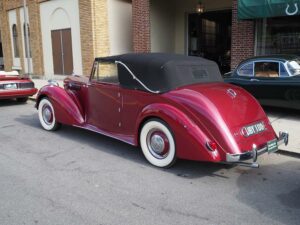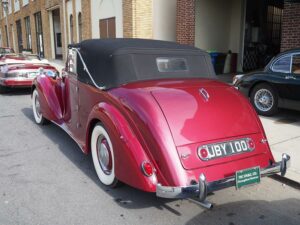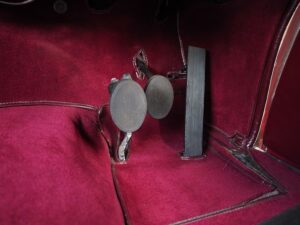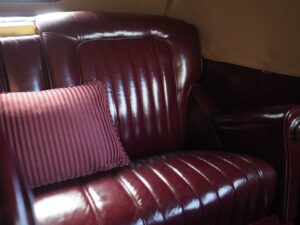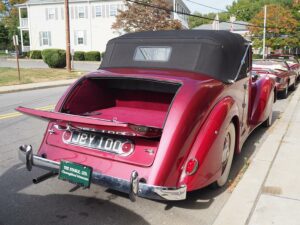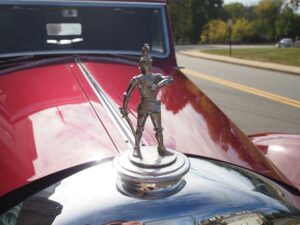- Profile
- prev
- next
- Share
- prev
- next
Description
It’s post-World War II and the world is trying to cope with the post-war economic trauma. Many companies are struggling to survive, and The Invicta Car Development Company was no different. There are many opinions on why they brought out such a radical, advanced car with such a high price tag at a time when most people were unable to meet their monthly expenses. The most common theory is that the features would attract a wealthy clientele with deep pockets and the high price would ensure sufficient profitability for a smaller volume of production. Good formula should succeed!
A car with a lovely design, with both drop head and saloon versions displaying flowing lines. The interiors were good for the era and the concept in general was bold to say the least. Invicta only gave a rolling chassis to their customers and a choice of a Byfleet Drophead Coupe or a Wentworth Saloon body. The rolling chassis was priced at UKP 1,850, the Drophead for UKP 2,500 and the Saloon price was provided on application only!
Invicta released the Black Prince in 1946 as part of their plans to revive the company that ceased production several years before WWII. The Black Prince was designed to take on the British luxury car heavyweights, Jaguar, Bentley and Rolls-Royce. To achieve this, the Black Prince featured many options that its rivals did not, including the highest quality leather interior, an aluminum body, aluminum engine block, fully suspension, in-built electric jacking system and trickle charger, interior heating and built in radio. These options meant the car would be priced 3 times higher than the new Jaguar Mk V and level with the latest Bentley.
It had a smooth 3-litre, 6-cylinder Meadows engine with triple carbs and twin plugs per cylinder engine that produced 120bhp, with pre-attached hydraulic jacks for each wheel in the event of a puncture. It’s believed that 18 complete cars were made and one prototype. Of these, 13 are currently accounted for around the world, five of them are dropheads.
The modernity of the power plant was mirrored by most of the car’s other technical attributes. All-round independent suspension with sliding pillars and torsion bars; four built-in electrically operated hydraulic jacks; floor and seats on a separate subframe with silentblocs to increase comfort; all-hydraulic Girling brakes (in-board at the rear); 24-volt electrics; a complicated heater and all the bells, whistles and radio sets one might wish for in 1946.
The Invicta Black Prince was a bold and luxurious British automobile produced in 1947. With only 16–18 units ever built, it remains one of the rarest and most technologically advanced cars of its time. Designed for aristocrats and visionaries, it combined cutting-edge engineering with bespoke craftsmanship.
Engineering Highlights
-
Engine: 3.0L DOHC inline-six with triple SU carburetors
-
Horsepower: Approx. 127 hp
-
Transmission: Electromagnetic pre-selector gearbox
-
Suspension: Fully independent front and rear
-
Brakes: Hydraulic system
-
Top Speed: ~107 mph
“A car decades ahead of its time, built for those who dared to dream beyond convention.”
Design & Luxury
-
Coachwork: Crafted by Charlesworth
-
Body: Lightweight aluminum construction
-
Interior: Hand-stitched leather, polished wood trim
-
Features: Electric heating, advanced instrumentation
Available in saloon and drophead coupe variants, the Black Prince exudes timeless elegance with sweeping fenders, a stately grille, and a long bonnet that hints at its power.
How It Compares
|
Feature |
Invicta Black Prince |
Bentley Mark VI |
Lincoln Continental |
|
Engine |
3.0L I6 |
4.3L I6 |
5.0L V12 |
|
Horsepower |
~127 hp |
~130 hp |
~130 hp |
|
Suspension |
Fully independent |
Independent front |
Coil front, leaf rear |
|
Transmission |
Electromagnetic |
Manual |
Manual w/ overdrive |
|
Production Volume |
~18 units |
~5,000 units |
~738 convertibles |
Legacy
The Black Prince was Invicta’s final flourish—a car that dared to challenge the norms of post-war automotive design. Though the company folded shortly after, the Black Prince lives on as a collector’s treasure and a symbol of British ingenuity.
Collector’s Note
If you’re fortunate enough to encounter one of these rare machines, you’re looking at a piece of history. Whether displayed at concours events or tucked away in private collections, the Black Prince remains a crown jewel of post-war motoring.
The 1947 Invicta Black Prince: Britain’s Forgotten Masterpiece
By T.H, Rossiter
A Post-War Dream in Aluminum and Ambition
In the shadow of World War II, Britain’s automotive industry was rebuilding—cautiously, conservatively. But one marque dared to defy the trend. Invicta, a name already steeped in pre-war racing prestige, re-emerged in 1947 with a car so advanced, so luxurious, and so rare, it seemed almost mythical: the Black Prince.
Crafted for the elite and engineered with visionary precision, the Invicta Black Prince was not just a car—it was a statement. A mere 16 to 18 units were ever produced, making it one of the rarest British automobiles of the 20th century.
Engineering Excellence
At the heart of the Black Prince was a 3.0-liter DOHC inline-six engine, fed by triple SU carburetors and capable of producing approximately 127 horsepower. This was no ordinary post-war powerplant—it was a technical marvel, paired with an electromagnetic pre-selector gearbox that allowed seamless gear changes with a flick of a switch.
The car featured fully independent suspension front and rear, a rarity even among luxury vehicles of the time. Hydraulic brakes and a top speed of around 107 mph placed the Black Prince in a league of its own—more sports car than stately saloon.
Design That Dared
Coachbuilt by Charlesworth, the Black Prince’s body was constructed from lightweight aluminum, giving it both elegance and performance. Its long bonnet, sweeping fenders, and regal grille conveyed power and sophistication. Inside, the cabin was a sanctuary of hand-stitched leather, polished wood, and advanced instrumentation. Electric heating and other modern conveniences made it feel decades ahead of its time.
Available in both saloon and drophead coupe configurations, each Black Prince was a bespoke creation, tailored to its owner’s desires.
A Brief Reign
Despite its brilliance, the Black Prince was born into a world not yet ready for such extravagance. Post-war austerity, high production costs, and limited demand led to Invicta’s quiet exit from the automotive stage shortly after the car’s debut. The Black Prince became a swan song—an exquisite final note in the brand’s storied history.
Legacy and Rarity
Today, the Invicta Black Prince is a collector’s dream. With fewer than 20 examples ever built, each surviving car is a treasure. It represents not just a rare piece of automotive engineering, but a bold vision of what British motoring could have been.
Whether displayed at concours events or tucked away in private collections, the Black Prince remains a symbol of innovation, elegance, and ambition.
Specifications at a Glance
|
Feature |
Details |
|
Engine |
3.0L DOHC I6, triple SU carbs |
|
Horsepower |
~127 hp |
|
Transmission |
Electromagnetic pre-selector |
|
Suspension |
Fully independent (front & rear) |
|
Brakes |
Hydraulic |
|
Top Speed |
~107 mph |
|
Body |
Aluminum, coachbuilt by Charlesworth |
|
Variants |
Saloon, Drophead Coupe |
|
Production Volume |
~16–18 units |
Final Thoughts
The 1947 Invicta Black Prince is more than a car—it’s a time capsule of post-war optimism and engineering daring. It reminds us that innovation often comes from those willing to take risks, even when the world isn’t quite ready. Our Black Prince has a 4-speed manual transmission mated to what is believed to be a BMC straight 6 greatly improving its drivability on today’s thoroughfares!
Specifications
-
Price$65000
-
Vehicle TypeConvertible
-
ColorRed
-
Interior ColorRed









